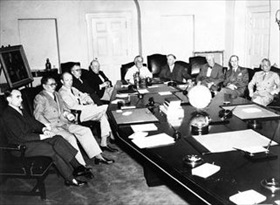ROOSEVELT, CHURCHILL TO PLOT WAR ON AXIS
Aboard HMS Duke of York · December 12, 1941
On this date in 1941 British Prime Minister Winston Churchill, fearing that the immediate impact of Japan’s attack on the U.S. naval base at Pearl Harbor in Hawaii would be a retreat into an “America-comes-first” posture, boarded the battleship HMS Duke of York for an Atlantic crossing to confer with President Franklin D. Roosevelt about coordinating strategies in their joint war against Japan (since December 8), Germany, and Italy. The latter two nations had been at war with Great Britain for many months, but with the U.S. only since December 11, 1941.
Churchill arrived in the nation’s capital on December 22 in great secrecy—even the president’s wife, Eleanor, was one of the last to be told of the White House’s new guest, much to her ire. While the two Roosevelts and Churchill’s party sat down to a Christmas dinner of oysters, turkey, chestnut dressing with giblet gravy, beans, cauliflower, and sweet-potato casserole, the two nations’ chiefs of staff convened and embraced Roosevelt’s emphasis that American troops had to be seen “in active fighting across the Atlantic.” Driving their thinking was the need to relieve pressure on the besieged Soviets, whose annihilation Adolf Hitler sought in his now faltering Operation Barbarossa, by forcing the German Wehrmacht (armed forces) to withdraw precious divisions on their Eastern Front and move them to the West, to occupied France and the Low Countries. This would, it was hoped, dissuade Soviet dictator Joseph Stalin from pursing a separate peace with Germany—a peace that could mark the Soviet Union’s exit from the war and divert millions of the enemy to the West just as a similar peace between Russia and Germany in March 1918 had done. (That separate peace with Russia nearly resulted in Kaiser Wilhelm’s Germany winning World War I.) Hence, the origins and the urgency of Operation Torch, begun November 8, 1942, the first Anglo-American assault on Axis forces since the European war’s outbreak.
The Torch landings in Northwest Africa finally stopped the swings of fortune, unmatched in any other theater of war, where first one side then the other had the upper hand. Overwhelming Allied resources whittled down, squeezed, and finally captured the last Italian and German forces in Tunisia in May 1943, setting the stage for Operation Husky, the initial Anglo-American assault on Fascist Italy.
![]()
Momentary “Wartime Capital of the World”: First Washington (Arcadia) Conference, December 22, 1941, to January 14, 1942
 |  |
Left: Prime Minister Winston Churchill, left, and President Franklin D. Roosevelt face each other at a conference table in the White House, Washington, D.C., December 22, 1941. Roosevelt had initially resisted Churchill’s urgent request for face-to-face discussions, coming as it did one day after both nations had declared war on Japan—Roosevelt wanting more time to come up to speed on the dramatic unfolding events. The president changed his mind when he learned that the Japanese had sunk the British battleship HMS Prince of Wales and the battle cruiser HMS Repulse off the east coast of British Malaya. Churchill’s three-week stay as the Roosevelts’ White House guest helped forge a close working friendship between the two world leaders that lasted until Roosevelt’s death in April 1945.
![]()
Right: Roosevelt (center rear) flanked by Churchill (on the President’s right) and Canadian Prime Minister Mackenzie King (on President’s left) at the First Washington Conference (Arcadia Conference), December 22, 1941, to January 14, 1942. The second of nine face-to-face conferences between Roosevelt and Churchill had its start aboard the HMS Duke of York in Chesapeake Bay, Maryland, on the day of Churchill’s arrival. (Their first meeting had been the Placentia Bay Conference the previous August aboard the cruiser USS Augusta off the Canadian coast of Newfoundland.) The First Washington Conference established the Combined (American and British) Chiefs of Staff, to be headquartered in Washington, D.C.; established a combined American-British-Dutch-Australian (ABDA) command for the Southeast Asia Theater; and framed the United Nations Declaration, announced to the world on January 1, 1942.
Winston Churchill Speaking Before the British House of Commons, December 8, 1941, Announcing War Against Japan
![]()

 History buffs, there is good news! The Daily Chronicles of World War II is now available as an ebook for $4.99 on Amazon.com. Containing a year’s worth of dated entries from this website, the ebook brings the story of this tumultuous era to life in a compelling, authoritative, and succinct manner. Featuring inventive navigation aids, the ebook enables readers to instantly move forward or backward by month and date to different dated entries. Simple and elegant! Click
History buffs, there is good news! The Daily Chronicles of World War II is now available as an ebook for $4.99 on Amazon.com. Containing a year’s worth of dated entries from this website, the ebook brings the story of this tumultuous era to life in a compelling, authoritative, and succinct manner. Featuring inventive navigation aids, the ebook enables readers to instantly move forward or backward by month and date to different dated entries. Simple and elegant! Click 











